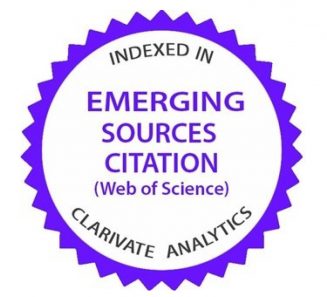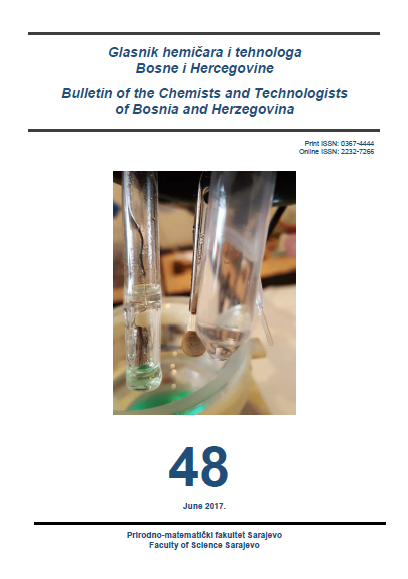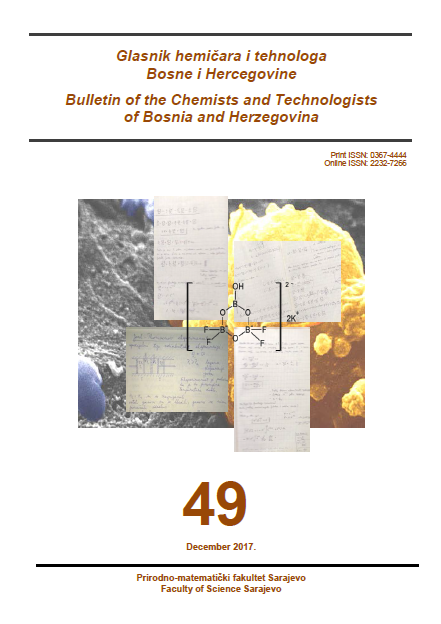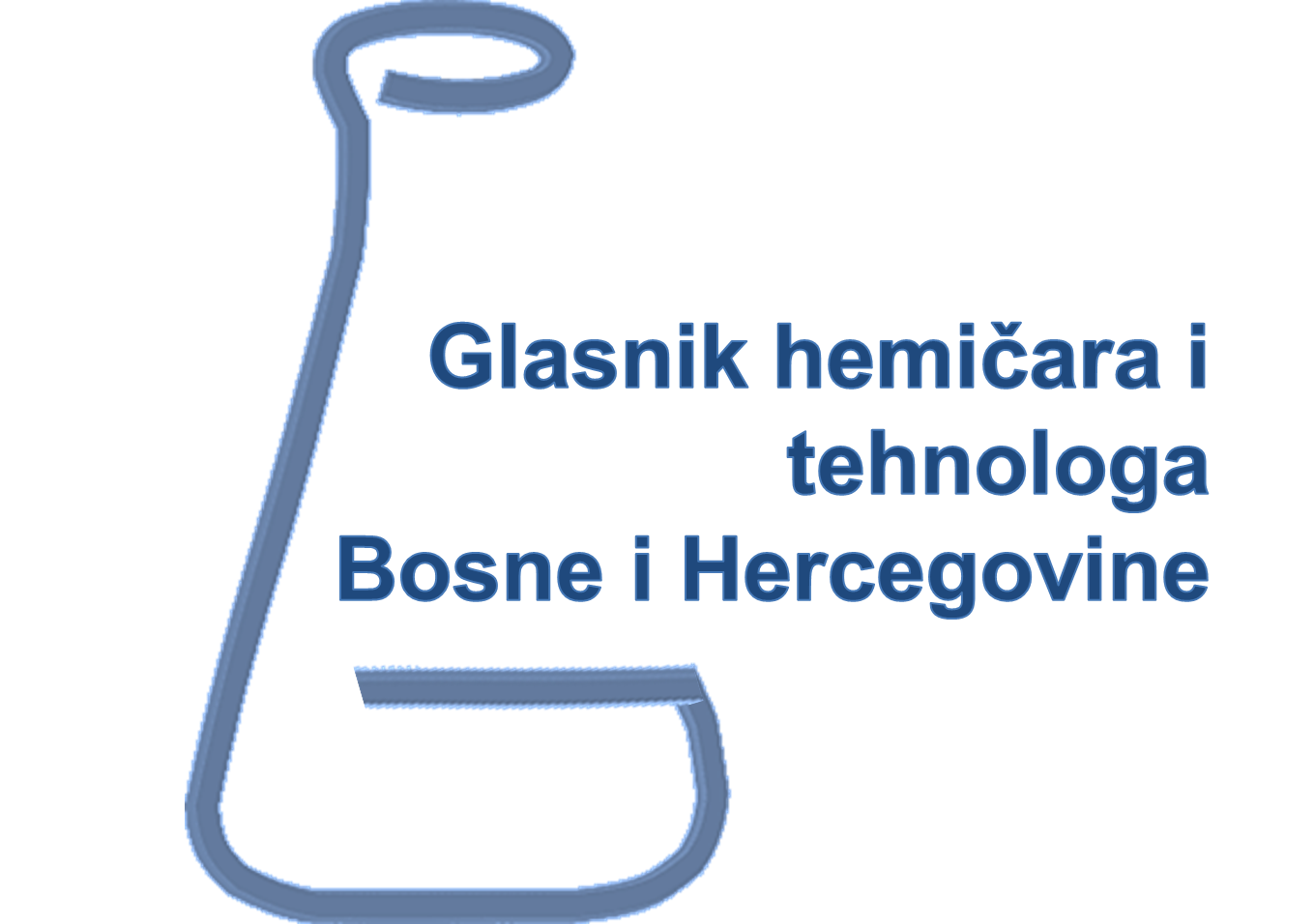|
|
Bulletin of the Chemists and Technologists of Bosnia and Herzegovina
Issue 47
Publication date: December 2016 |
|
Table of contents
Synthesis and characterization of Ru(III) complexes with thiosemicarbazide-based ligands Original Scientific Article
Ljubijankić Nevzeta, Tešević Vele, Grgurić-Šipka Sanja, Jadranin Milka, Begić Sabina, Buljubašić Lejla, Markotić Ena, Ljubijankić Sead
Abstract: Three Ru(III) complexes general formula Na[RuL2] (where L = dibasic tridentate thiosemicarbazone ligands) have been synthesized by reacting RuCl3 with thiosemicarbazide-based ligands with ONS donors. Ligands of general formula (X)N-NH-C(S)-NH2 were prepared through the condensation reaction of salycilaldehide or its derivatives (X = salicylaldehyde, 5-Cl-salicylaldehyde, 5-Br-salicylaldehyde) with thiosemicarbazide. Complexes have been formulated and characterized by mass spectrometry and infrared spectroscopy. The data showed the formation of a complex with a 1:2 metal:ligand stoichiometries.The ligands coordinated as an ONS tridentate dianion through the oxygen atom of the deprotonated phenolic OH-group, the azomethine nitrogen atom andthe sulfur atom after deprotonation of the thiosemicarbazide residue in its thiol form.
Bulletin of the Chemists and Technologists of Bosnia and Herzegovina 47, 1-6.
Calcium Analysis in Bones During Aging Process Original Scientific Paper
Šapčanin Aida, Sofić Emin
Abstract: The resorption process in bone organ culture can be measured and evaluated by only measuring the calcium concentration in the medium with calcium ion-selective electrode. Reliable and consistent calcium resorption from bone using 500 ng/ml prostaglandine E2 or 250 ng/ml human parathyroid hormone (1-34) have occurred. The results, thus, indicate that calcium can be considered as an independent index of bone resorption. Our preliminary measurements by atomic absorption spectrophotometry (AAS), although statisticaly unrepresentative the sample – group being 9 babies and 9 adults, point to such conclusion. Bones were taken postmortem or post operationem. Calcium concentration measured by AAS was at range of about 260 mg Ca/ mg ash in the human baby bones (costae) and of about 430 mg Ca/mg ash in the human adults bones (femur). Calcium amount measured also in the calvaria of five-day old mice ICR strain by AAS. Values were at range of about 45 mg Ca/mg ash. AAS is a reference method for calcium determination in human bones, however for simplification it is more appropriate to use calcium ion-selective electrode.
Bulletin of the Chemists and Technologists of Bosnia and Herzegovina 47, 7-10.
Spectroscopic Investigations of Co(II) and Cu(II) Interaction with Imatinib Mesylate and Capecitabine Original Scientific Paper
Cipurković Amira, Horozić Emir, Crnkić Aida, Marić Snježana, Ljubijankić Nevzeta
Abstract: Cobalt and copper are present as trace elements in biological systems andthey are very important for the activity of many enzymes with different functions inthe body. Their biological functions derive from the possibility of potential interactionof their M(II) ions with O, N and S donor atoms of various ligands and biomoleculesin the living organisam. Capecitabine and imatinib mesylate (ImM) are synthetic organiccompounds which are used in a treatment of some oncological diseases thus disturbinghomeostasis of biological system.In this study, UV and FTIR spectroscopic methods are used to investigate metalligand interactions and products of their interaction at physiological conditions using model test systems. FTIR spectrum of Co(II)-capecitabine model systems show lack of absorption bands characteristic for -OH (at 3230 cm-1) and C=O groups positioned at pyrimidine cycle (at 1718 cm-1) for pure capecitabine. It indicates interaction of Co(II) ion with capecitabine via O-donor atoms. FTIR spectrum of pure ImM deviates from spectrum of Co(II)-ImM system at 1250-1050 cm-1 wavelength region. This region corresponds to peaks characteristic for mesylate ions (O3S-CH3), which indicates on interaction between Co(II) and donor atoms containing molecule ligands (O and/or S).
UV results for model systems of M(II) with capecitabine and ImM show similar absorption bands as those of pure ligand, while absobances are different (except for Cu(II)-ImM). Since these investigations are done at approximately at physiological conditions, it is expected that, after application of these ligands as pharmacological agents, the same interactions are happening in the human body.
Bulletin of the Chemists and Technologists of Bosnia and Herzegovina 47, 11-16.
Antimicrobial effects of garlic (Allium sativum L.) Original Scientific Paper
Strika Ilma, Bašić Aida, Halilović Namir
Abstract: Garlic has been used as a source of food and medicine for thousands of years. Given that the garlic contains different biologically active materials and acts as an antibiotic and a fungicide, the purpose of this research was to estimate the degree of sensitivity of three different Gram-positive bacteria: Staphylococcus aureus, methicillin-resistent Staphylococcus aures (MRSA) and Bacillus subtilis; two types of Gram-negative bacteria: Escherichia coli andSalmonella enteritidis; as well as the fungus Candida albicans. The degree of sensitivity of tested microbes with regards to the agency of fresh and thermally processed local and imported garlic was determined using the disc-diffusion method. Examined antimicrobial-test substances exhibited antibacterial effect on all tested gram-positive bacteria and gram-negative bacteria, as well as the fungistatic agency upon fungus C. albicans. The strongest antimicrobial effect on all tested species was exhibited by fresh local garlic. Preparates based on A. sativum could be introduced in clinical practice for the treatment of infections caused by C. albicans.
Bulletin of the Chemists and Technologists of Bosnia and Herzegovina 47, 17-20.
Heavy metals pollution in children playgrounds -an environmental modelling and statistical analysis Original Scientific Paper
Šapčanin Aida, Čakal M, Ramić Emina, Smajović A, Pehlić Ekrem
Abstract: Models could be used to simulate target variable responses to changes in very complex systems such as soils polluted by heavy metals. Chemical properties of soil such as pH in H2O, pH in 1 mol/L KCl, humus and CaCO3 could influence metal mobility and can be used to assess impact of various antropogenic activities. The soil samples were collected from playgrounds located in different areas of Sarajevo. Heavy metals: Cd, Pb, Cu and Zn and basic chemical properties of soil were determined. Statistical analysis was conducted to obtain the correlation coefficient of two selected variables in a data sample, as a normalized measurement of how the two are linearly related. Determined content (mg/kg) for Cd, Pb, Cu and Zn in the spring season were in the ranges of: 0.91-2.15; 26.69-118.97; 19.14-80.21; 75.85-161.45 and in the autumn season were in the ranges of: 0.80-2.14; 41.07-152.71; 29.46-140.74; 71.77-199.04, respectively. The results showed that the highest correlation coefficient was 0.91, for the total content of Cu in the soils in regard to the content of Pb in the autumn season and this indicates a strongand positive correlation. Generally, our results could be used for prediction of heavy metal distribution in playground soil.
Bulletin of the Chemists and Technologists of Bosnia and Herzegovina 47, 21-26.
Synthesis and Characterization of Neutral Ru(III) Complexes Containing Schiff Bases and N-donor Heterocyclic Ligands Original Scientific Paper
Begić Sabina, Ljubijankić Nevzeta
Abstract: Two new neutral complex compounds of Ru(III) with Schiff bases and N-donor heterocyclic ligands have been synthesized. Based on MALDI TOF/TOF mass spectra, CHN elemental analysis, infrared and electronic spectra the synthesized compounds were formulated as [RuCl(N-Ph-5-X-salim)2B], where X = Cl for B = Py and X = Br for B = Pym. In the octahedral environment of Ru(III), bidentate Schiff bases acts as anionic ligand where coordination occurs via deprotonated phenolic oxygen and azomethine nitrogen atom. Coordination of monodentate N-donor heterocyclic ligands occurs through free electronic pair on the nitrogen atom.
Bulletin of the Chemists and Technologists of Bosnia and Herzegovina 47, 27-32.
The phosphate removal efficiency electrocoagulation wastewater using iron and aluminum electrodes Original Scientific Paper
Đuričić Tijana, Malinović, Borislav, Bijelić, D.
Abstract: Effects of electrolysis duration, initial phosphate concentrations and supporting electrolyte concentrations on the phosphate removal efficiency by electrocoagulation using either aluminum or iron electrodes were investigated in this study. All experiments were performed in a batch electrochemical reactor on synthetically prepared wastewater of the initial volume 0.2 L. The results indicate that increase of initial phosphate concentration has reduced removal rate, and by increasing the electrolysis duration removal efficiency increases. It was found that the aluminum electrode has higher removal efficiency (98.9%) compared to the iron electrode (93.5%) for 40 minutes of treatment (pH=3, j=1mA/cm2, γ0=50 mg/L P–PO4). The addition ofsupporting electrolyte (gNaCl=0.25 g/L) is achieved removal efficiency of 50.2% for Fe and 52.1% fo Al electrode in only 10 minutes of treatment, respectively.
Bulletin of the Chemists and Technologists of Bosnia and Herzegovina 47, 33-38.
Mathematical modeling and simulation of the composting process in a pilot reactor Original Scientific Paper
Papračanin Edisa, Petric Ivan
Abstract: In this paper, a mathematical model for composting process with an engineering approach was presented. The model describes the n-th order kinetics of composting process (mesophilic-thermophilicphase) with mass and heat balances in the process. Verification of the model was performed using experimental data obtained from a pilot reactor. Measured dynamic state variables used for a verification of the model were: organic matter mass, water mass in a mixture, amount of oxygen and carbon dioxide, temperature of mixture and the temperature of gas phase. The developed mathematical model was implemented in numerical software package MATLAB. Three kinetic parameters were estimated using the Marquardt method. Global sensitivity analysis and statistical F-test showed that the model is valid for predicting the change in five dynamic state variables. The advantage of the model is that it can be applied to the composting process with mixtures of different compositions in reactors with different volumes.
Bulletin of the Chemists and Technologists of Bosnia and Herzegovina 47, 39-48.
Development and validation of the mathematical model for synthesis of maleic anhydride from n-butane in a fixed bed reactor Original Scientific Paper
Petrić Ivan, Karić Ervin
Abstract: The aims of this study were the following: development of themathematical model for numerical simulation of partial oxidation of n-butane to maleic anhydride in a fixed bed reactor and validation of developed mathematical model with real process data from industrial reactor located in the Global Ispat Coke Industry Lukavac. Mathematical model is consisted of differential equations that describe mass balances of each species, energy balance, stoichiometry of reactions, pressure drop, kinetic model. Numerical software package Polymath with Runge-Kutta-Fehlberg method was used for numerical solution of differential equations. The developed mathematical model was validated with three process data sets of five measured variables (temperature, pressure, concentration of n-butane, concentration of carbon dioxide, concentration of carbon monoxide) and with application of ten kinetic models from literature. Comparison of simulation results and measured data showed a good agreement for three kinetic models. For the chosen kinetic model, profiles of temperature, molar flows, conversion of n-butane and selectivity of maleic anhydride were also presented.
Bulletin of the Chemists and Technologists of Bosnia and Herzegovina 47, 49-58.
Nanosensors applications in agriculture and food industry Technical Paper
Enisa Omanović-Mikličanin, Mirjana Maksimović
Abstract: Food safety is very important issue in food industry and agriculture because it is directly related to the influence of food on the human health. Recent food safety incidents (such as the melamine affair in 2007 and 2008) and public health concerns about synthetic food additives and chemical residues in food have driven the need to develop rapid, sensitive, and reliable methods to detect those food hazards. An alternative is given in the rapid development of nanosensors which have advantage to detect food components in an easy and quick manner. Linking nanosensors with modern Information and Communication Technologies (ICTs) enables novel and online ways for different components detection accompanied with high accuracy. Various types of nanosensors are being developed to meet the different requirements in food inspection (nanosensors for detection of external and internal conditions in food packaging, carbon nanotubes based electrochemical sensors for detection of cations, anions and organic compounds in food, various aptamers for detection of pesticides, antibiotics, heavy metals, microbial cells and toxins).
The work reviews development and application of the most present nanosensors in agriculture and food industry.
Bulletin of the Chemists and Technologists of Bosnia and Herzegovina 47, 59-70.






 Full version of Bulletin
Full version of Bulletin
